 Indians Archive
Indians Archive  Indians Prospect Countdown: #15-11
Indians Prospect Countdown: #15-11
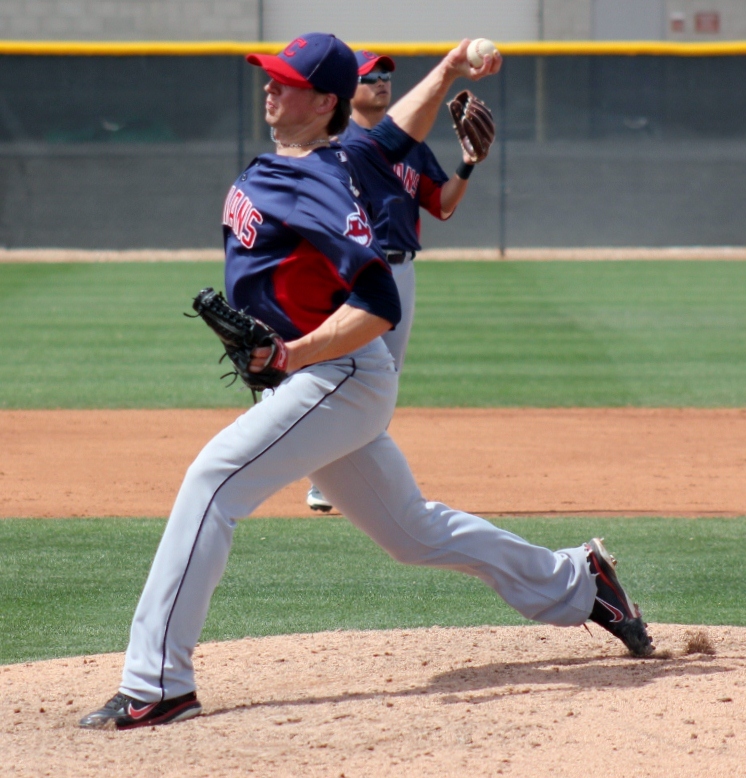 We're really getting into rarefied air now, as we look at the #15-11 prospects in the entire Indians system. Unsurprisingly, we're going to take a look at another power righthanded reliever, but this time it will be the best power righthanded reliever who has yet to grace the mound on the corner of Carnegie and Ontario. Additionally, we'll look at a lefty who has already seen time with the big club, a 2011 draft pick looking to pick up the pieces after a disasterous 2012, a breakout 2B who went from unranked last year to just shy of the top-10 this year and finally...#WASHTIME!
We're really getting into rarefied air now, as we look at the #15-11 prospects in the entire Indians system. Unsurprisingly, we're going to take a look at another power righthanded reliever, but this time it will be the best power righthanded reliever who has yet to grace the mound on the corner of Carnegie and Ontario. Additionally, we'll look at a lefty who has already seen time with the big club, a 2011 draft pick looking to pick up the pieces after a disasterous 2012, a breakout 2B who went from unranked last year to just shy of the top-10 this year and finally...#WASHTIME!
15. Trey Haley, RHP
DOB: 6/21/1990
Height/Weight: 6-3/180 lb.
Bats/Throws: Right/Right
Acquired: 2nd round pick in the 2008 draft
2012 Stats: 4-1, 2.33 ERA with 49 K and 19 BB in 38 2/3 IP between Rookie Arizona, Carolina and Akron.
Scouting Report: If you saw Trey Haley walking down the street, the first thought that would pop into your head would likely be “this guy is a pitcher.” He just looks like he was built to throw a baseball. Tall, strong, with long arms and legs, it’s easy to see where Haley gets his velocity from. His 2.33 ERA from last year is actually deceptively high; 5 of the 10 ER Haley allowed last season occurred in 6 innings of rehab work with Rookie League Arizona. In 32 2/3 IP in Carolina and Akron, Haley allowed just 5 ER on 18 hits, striking out 40 and walking 17. He didn’t allow a single HR last year, and has given up just one longball since the beginning of the 2011 season (83 IP). Haley was a starter through the 2010 season, but the Indians began the transition to the bullpen in 2011 due to control and durability problems. But as far as pure arms go, Haley has one of the best in the organization.
Haley has one of the best fastballs in the organization, a plus-plus four-seamer that sits comfortably in the 94-96 MPH range and can touch triple digits. He also has a two-seamer that has a little less velocity, but nice sinking action and generates a lot of groundballs. Haley has the ability right now to get minor league hitters out with just his fastball-sinker combination. But he compliments his fastballs with a solid curveball that flashes plus, a slider and a developing changeup. The curveball is his best secondary offering at this stage of his career, a pitch that became much more consistent last year. His slider lags behind the curve, but it has a lot of potential as a real swing and miss pitch for Haley because it’s velocity is close enough to his fastball to fool a lot of hitters. He uses the changeup sparingly, but scouts that have seen it say it’s a potential weapon for him down the road if he can continue to refine the pitch. It’s an impressive repertoire for a reliever, something that Haley benefits from due to his days as a starter.
Haley missed time the past two seasons with what he thought was a groin injury, but ended up being diagnosed as a sports hernia. He had surgery to finally correct the lingering issue midseason last year, and when he came back he was stronger and more effective than ever. Haley was transitioned to the bullpen in part due to his durability issues and in part due to his spotty command. There’s a decent chance now that the hernia is finally fixed that one or even both of those issues could be behind him. Haley is a big, athletic kid with a very clean, repeatable delivery. There’s no mechanical flaw holding him back from having better command, and if he can cut down on the walks and locate his fastball in the zone, then there’s a possibility that he could end up in the rotation again down the road. An arm as talented as his almost seems like a waste in the bullpen, as even as an elite closer he’d only be throwing 60-80 innings per season as opposed to 200+ as a starter. I’m not sure what the Indians have in mind for the talented righty out of Nacogdoches, TX, but if he returns to a starting role, there’s a chance that he’s a top-5 prospect in the organization next year. As it is he has the potential to be a backend arm in a major league bullpen as soon as this season, although he could use some additional seasoning in the minors. It will be interesting to see what the Tribe brass ends up doing with Haley, as with a little patience I think he can still be a starter in the major leagues.
Haley pitched effectively in the elite Arizona Fall League this past offseason, was added to the 40-man roster. He’s clearly in the Indians plans for the future, it’s just a matter of how soon and in what role. He’ll likely open up 2013 with AA Akron, but could move quickly to AAA Columbus if he remains in the bullpen. He has an outside shot at pitching in the major leagues as soon as 2013 if the big club has a need for a righthander out of the bullpen.
Glass half-full: A #2 starter in a major league rotation
Glass half-empty: An elite backend reliever
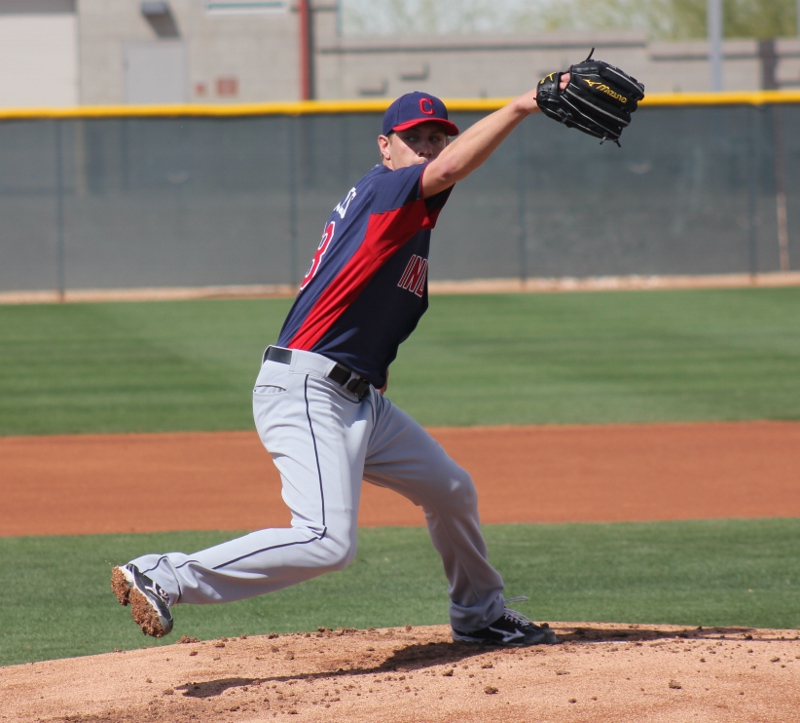 14. Scott Barnes, LHP
14. Scott Barnes, LHP
DOB: 9/5/1987
Height/Weight: 6-4/200 lb.
Bats/Throws: Left/Left
Acquired: From San Francisco in exchange for Ryan Garko in 2009
2012 Stats: 0-0 with a 4.26 ERA, 16 K and 7 BB in 19 IP for Cleveland; 2-3 with a 3.98 ERA, 67 K and 23 BB in 52 IP with Columbus.
Scouting Report: Drafted after his junior year at St. John’s University, Barnes had been a starter for his entire professional career until last season. He opened up in the Clippers rotation, but after just three starts Barnes transitioned to a bullpen role to fit with the needs of the parent club. He dominated AAA hitters, and was hit-and-miss in 19 innings over a pair of stints with the big club. He had a chance to make his MLB debut in 2011, but tore his ACL coming off the mound to field a bunt in July of that year while with the Clippers.
Barnes pitches primarily off of his fastball, an above-average offering from the left side that sits consistently between 91-94 and can touch as high as 96. His velocity plays up due to his deceptive delivery, as Barnes has a funky motion that hides the ball from the hitter until the last second. He compliments the fastball with an above-average slider and a developing changeup. When his changeup is on, Barnes can be effective against hitters on both sides of the plate. The pitch has excellent down and away action with a righthanded hitter at the plate, and that pitch will be the key for Barnes becoming more than just a LOOGY at the major league level. Barnes was outstanding against righties while with Columbus, as he allowed just 19 hits in 36 IP while striking out an impressive 51 hitters. That success didn’t carry over to the major leagues, as Barnes allowed 5 runs, 2 HR and struck out just 8 in 10 1/3 innings against righties in The Show. Fastball location and pitch sequencing are going to be important for Barnes in the majors, and having three pitches as a lefthanded reliever is a luxury that he needs to exploit.
I was a little surprised when the Indians moved Barnes to the bullpen, as I thought (still think) he has the stuff to be a solid back of the rotation starter and would be more valuable in that role. The team clearly feels that the relief role is the right place for Barnes though, so that’s where he’ll stay for 2013 at least. His stuff clearly plays up in shorter bursts (17 K in 16 AAA IP as a starter and 50 K in 36 AAA IP as a reliever), and with his history in the rotation he’s a guy who can be stretched out over multiple innings if that’s what the situation calls for. He should get every opportunity to open the season at the corner of Carnegie and Ontario, especially after the trade of fellow LHP Tony Sipp this offseason. Barnes is 25 now, so his developmental arc is more or less complete; he doesn’t have a lot of projection in him at this point. He’s a versatile arm that throws a mid-90’s fastball from the left side, and that’s something that will never go out of style. I’d expect Barnes to be more effective this season after getting his feet wet in Cleveland last year, and think he can stick in the Bullpen Mafia for most if not all of the 2013 season.
Glass half-full: A solid backend reliever, or even a transition back to starting where he could be a solid back of the rotation arm
Glass half-empty: Long man out of the bullpen
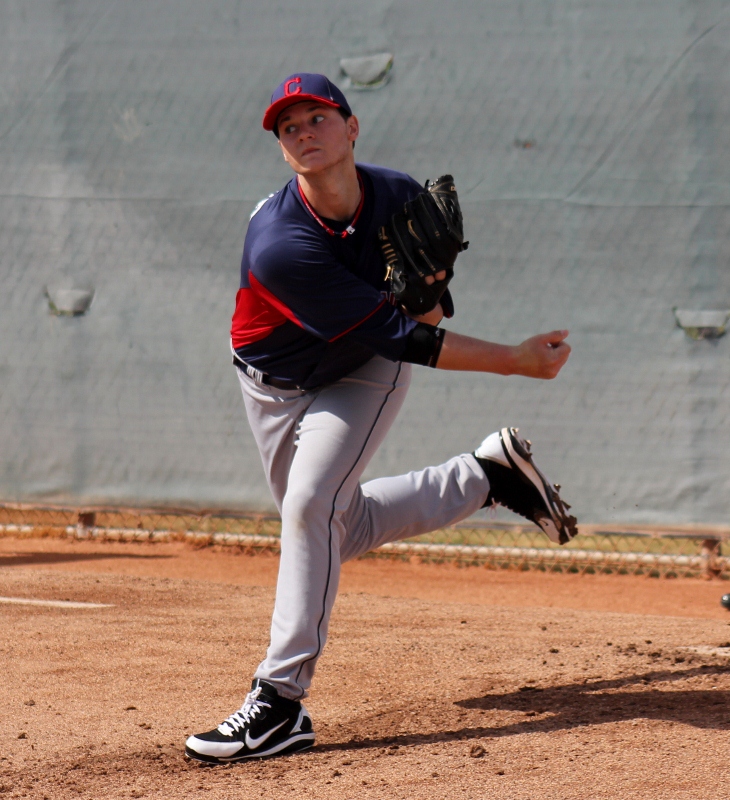 13. Dillon Howard, RHP
13. Dillon Howard, RHP
DOB: 7/1/1992
Height/Weight: 6-4/210 lb.
Bats/Throws: Right/Right
Acquired: 2nd round pick in the 2011 MLB draft
2012 Stats: 1-7, 7.90 ERA 35 K and 18 BB in 41 IP for Rookie League Arizona
Scouting Report: Yikes. If there are women and children around, please hide last year’s stat line from their eyes. Howard had probably the most disappointing year in the entire system, as the pitcher that I had ranked as the #2 prospect in the organization didn’t pitch outside of the complex leagues, and he got lit up like a pinball machine while he was down there. Howard suffered through some nagging injury issues throughout spring training and in extended spring training, and his highly-anticipated debut in low-A Lake County never even happened. When he did pitch, his stuff was worse than when he was a high school senior, and the unexpected step back in velocity resulted in his struggles on the mound. It was a lost season for the 19-year old righthander, and one can only hope it was more of a blip on the radar than a harbinger of things to come.
When he was in high school, Howard showcased a heavy, low-90’s sinker that resulted in a lot of swing and misses and groundballs. He complimented that pitch with a lively 4-seam fastball that ran up into the mid-90’s, and used the pitch effectively up in the zone to get hitters to chase. His secondary pitches are an above-average changeup that could be a plus pitch down the road, and a solid curveball. The curve was considered to be the pitch Howard needed to work on the most, as he has a tendency to overthrow the pitch which causes it to get slurvy, flatten out and get hit hard. His senior year in high school, Howard went 9-1 with 0.31 ERA and 115 K in 58 innings of work. In case you’re trying to do the math in your head, that breaks down to just 2 earned runs allowed. He was a unanimous selection for HS Player of the Year in Arkansas, and was seen as a polished high school arm that had the potential to move quickly through the professional ranks.
The only time I was able to see Howard pitch was in a bullpen session in Spring Training last year, so I can’t even speculate as to what went wrong for the talented righty in 2011. He had a 1st round grade coming out of high school, and only fell to the Indians in the 2nd round because of signability concerns. The Indians inked him to an overslot bonus of $1.85 million, and were lauded by the experts for spending the money to bring Howard into the fold. That kind of talent does not simply evaporate, so I’m hoping his struggles were a combination of injuries, ironing out mechanics and adjusting to life as a professional baseball player. The really concerning thing was the drastic dip in velocity, as reports had Howard struggling to crack the 90 MPH barrier on the radar gun. He’s a difficult player to rank because of the talent and performance gap so far in his brief career, and this ranking shows that I’m giving him at least a partial mulligan for last year. But if he has another season like 2012, we’re going to be talking about him as a bust.
Glass half-full: A solid #3 in a major league rotation
Glass half-empty: Whatever happened in 2011
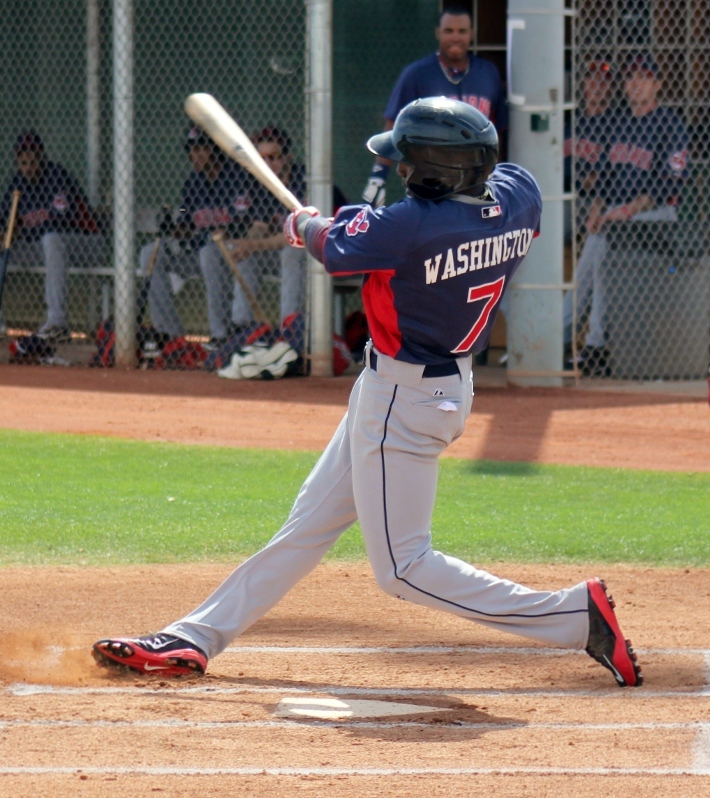 12. LeVon Washington, OF
12. LeVon Washington, OF
DOB: 7/26/1991
Height/Weight: 5-11/170 lb.
Bats/Throws: Left/Right
Acquired: 2nd round pick in 2010 MLB draft
2012 Stats: .333/.439/.354 with 4 RBI and 1 SB in 13 games between Rookie-level Arizona, Lake County and Carolina.
Scouting Report: Someday soon, LeVon Washington is either going to make me look really smart or really silly. In 2 “full” seasons as a professional since signing in 2010, Washington has accrued far more twitter followers than games played, as the young OF has appeared in just 92 games in his brief career. #WASHTIME played in 79 uninspiring games in 2011, putting up a .647 OPS for low-A Lake County, as the Florida native suffered through a litany of nagging injuries that caused him to miss time throughout the season. Washington rededicated himself to his training in the 2011 offseason, reporting to Goodyear in 2012 in outstanding shape and with a new perspective on what to expect in professional baseball. Washington had an outstanding camp and came out of the gate red hot for the Lake County Captains in 2012, and a move to Carolina seemed imminent. Unfortunately, Washington suffered a torn labrum in his hip (he’d already torn the labrum in his shoulder in college) that ultimately required another surgery. He came back to play a few games with high-A Carolina at the end of the season, but it was basically a lost year for Washington due to the injury.
This ranking is all about projection at this point, but Washington’s raw tools are hard to ignore. He has above-average bat speed and a compact swing from the left side that generates surprising pop for a guy with his build. He’s never going to be a 30 HR guy, but 15-20 is not out of the question. He has gap power and plus speed, and that combination should translate into plenty of doubles and triples even if he doesn’t end up hitting a lot of balls out of the ballpark. He’s got a solid approach, can take a walk and do some damage on the basepaths once he gets there.
Defensively, Washington is either a CF or a LF. He has the speed for CF, but the previously-mentioned torn labrum that he suffered in his throwing shoulder during his college days has his arm topping out at fringe-average. It was well below average in 2010, but when I saw him making throws from the OF during Spring Training 2011 it had vastly improved. It will never be a weapon like a Naquin or Moncrief, but it’s not going to be Johnny Damon-esque like it was in 2010 either. He covers a lot of ground in the OF and that speed would be nice to have in LF, but his bat profiles better as a CF.
Washington has drawn Carl Crawford comparisons since he was in college, as the raw tools are that exciting. Unfortunately, Washington has followed in Crawford’s footsteps with respect to their checkered injury history, but without the corresponding success on the diamond. Again, this ranking is all about projection, as Washington hasn’t been healthy enough to do anything of note in the Indians organization since being drafted in 2010. But I can’t shake the impression he made on me in Spring Training last year, when he was the best player on the back fields, drilling balls into gaps, hustling around the bases and making spectacular plays in the OF. The tools and dedication to the game are there, Washington just needs a healthy season for a chance to pull it all together. If he can stay on the field in 2013, it could be a breakout year that sees him rank in the top-5 on next year’s prospect countdown.
Glass half-full: Carl Crawford, v.2010
Glass half-empty: Carl Crawford, v.2011/12
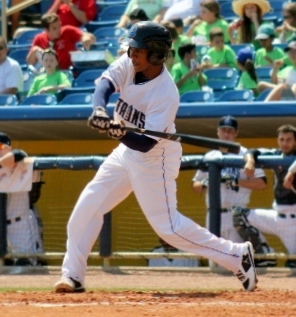 11. Jose Ramirez, 2B
11. Jose Ramirez, 2B
DOB: 9/17/1992
Height/Weight: 5-9/165 lb.
Bats/Throws: Switch/Right
Acquired: International free agent in 2009
2012 Stats: .354/.404/.465 with 3 HR, 27 RBI and 17 SB in 70 games between Mahoning Valley and Lake County.
Scouting Report: Ramirez is an easy guy to overlook before you see him in the batters box. When you see him playing catch, fielding grounders in warm-ups and jogging around the outfield, the thought that this is a .450+ SLG guy never really enters your mind. But once the physically unimposing switch hitter digs in and starts hitting BP, it’s easy to see why he’s ranked this highly on the prospect countdown. As a 19-year old in the difficult offensive environment of the Midwest League, Ramirez went out and slugged 20 XBH in 67 games, good for a .462 SLG and a .865 OPS. For a teenage 2B in his first appearance in a full-season league, those are some pretty good numbers.
Ramirez is not a big power guy, as his 3 HR last year would indicate. But he has a plus hit tool and above average speed, so that should translate into plenty of doubles and triples even if the over the fence power never really matures. He features a smooth, pretty swing from both sides of the plate, and his hands take a very natural path to the ball. He does a nice job barreling the baseball and makes surprisingly loud contact for a player his size. He’s a free swinger, but doesn’t strike out much and knows how to take a walk. His approach could use a little work, but he’s further ahead of most international signs his age as his 25 walks to 26 strikeouts last year would indicate.
Defensively, Ramirez is a solid 2B who projects to be an above-average defender. His glove is very consistent and he makes all the routine plays (just 2 errors last year). He’s quick and has good range, and the only thing holding him back from being a plus defender at 2B is his arm strength. His arm is fringe-average, and as such he has trouble making plays up the middle that require a strong off-balance throw to 1B. The arm limits him to 2B defensively, so while he’s a solid up-the-middle defender he’s never going to be a guy who can profile at SS.
Because he’s limited to 2B and doesn’t have much power projection, Ramirez’s value is directly proportional to his hit tool. Raw hitting ability is awfully tough to coach, so Ramirez has a step up over a lot of “tools guys” in the organization. He’s going to have to continue to hit at every step of the way though, as guys with his size and power projection aren’t going to be given as many opportunities as players with more “projection” in them. Ramirez will likely play all of 2012 in the high-A Carolina League, another difficult hitting environment that will test the young Dominican with some advanced offspeed stuff. If he can maintain his average and OBP in 2013 with the Mudcats it will be a very encouraging sign for his prospect status. It’s tough to ignore a 19-year old 2B with an .800+ OPS in the Midwest League, and will be even more difficult if he can repeat the feat in Carolina.
Glass half-full: A solid 2nd division starter at 2B.
Glass half-empty: The bat doesn’t play, and neither does Ramirez.
- NBA Announces 2013-2014 Schedule
- Browns Ink Sharknado
- Sharknado A No-Show For Rookie Camp
- Trent Richardson Out Until Training Camp
- Browns Sign Brandon Jackson
- Carrasco Suspended Eight Games
- Browns Add to Wide Receiver Depth with David Nelson
- Browns Need to Learn from Past Draft Mistakes
- Browns Release Chris Gocong and Usama Young
- Browns Missing on Grimes Disappointing, But Not The End
The TCF Forums
- Chris Grant's first 3 drafts
Kingpin74 (Tuesday, January 21 2014 10:13 AM) - The 2014 Offseason Thread
googleeph2 (Tuesday, January 21 2014 9:36 AM) - 2015 Recruiting
furls (Tuesday, January 21 2014 6:57 AM) - Mike Brown
YahooFanChicago (Monday, January 20 2014 11:15 PM) - Movies coming out
HoodooMan (Monday, January 20 2014 9:34 PM) - 2014 Hoops Hockey Hijinx
jpd1224 (Monday, January 20 2014 4:44 PM) - 2014 Recruiting
jclvd_23 (Monday, January 20 2014 2:26 PM) - Wish List - #4 Pick
Hikohadon (Monday, January 20 2014 1:26 PM) - Official- Browns Coach Search/Rumors
OldDawg (Sunday, January 19 2014 6:48 PM) - #1 overall pick Anthony Bennett
TouchEmAllTime (Sunday, January 19 2014 1:28 PM)


